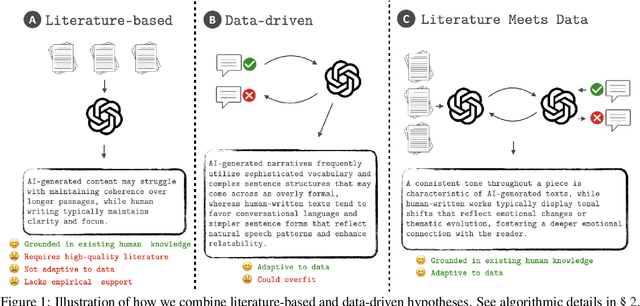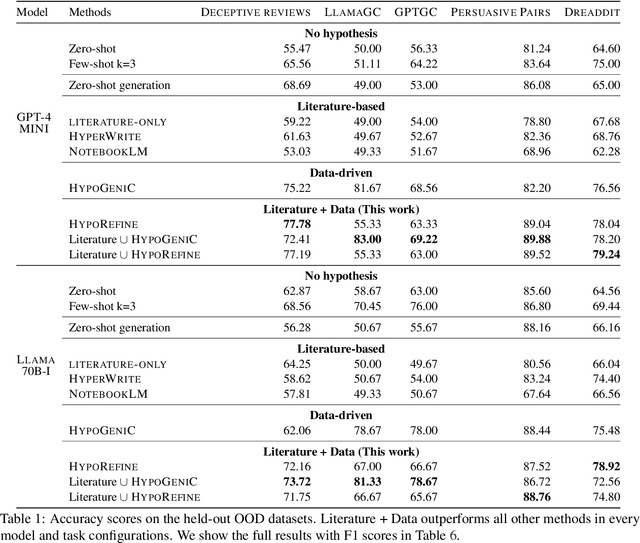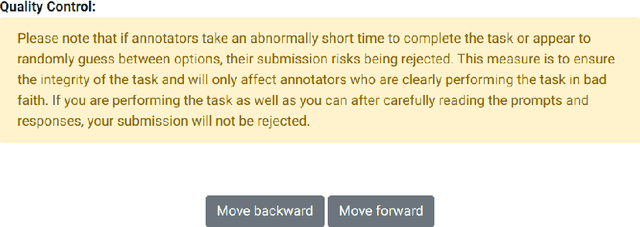Chenhao Tan
HypoBench: Towards Systematic and Principled Benchmarking for Hypothesis Generation
Apr 15, 2025Abstract:There is growing interest in hypothesis generation with large language models (LLMs). However, fundamental questions remain: what makes a good hypothesis, and how can we systematically evaluate methods for hypothesis generation? To address this, we introduce HypoBench, a novel benchmark designed to evaluate LLMs and hypothesis generation methods across multiple aspects, including practical utility, generalizability, and hypothesis discovery rate. HypoBench includes 7 real-world tasks and 5 synthetic tasks with 194 distinct datasets. We evaluate four state-of-the-art LLMs combined with six existing hypothesis-generation methods. Overall, our results suggest that existing methods are capable of discovering valid and novel patterns in the data. However, the results from synthetic datasets indicate that there is still significant room for improvement, as current hypothesis generation methods do not fully uncover all relevant or meaningful patterns. Specifically, in synthetic settings, as task difficulty increases, performance significantly drops, with best models and methods only recovering 38.8% of the ground-truth hypotheses. These findings highlight challenges in hypothesis generation and demonstrate that HypoBench serves as a valuable resource for improving AI systems designed to assist scientific discovery.
HypoEval: Hypothesis-Guided Evaluation for Natural Language Generation
Apr 09, 2025Abstract:Large language models (LLMs) have demonstrated great potential for automating the evaluation of natural language generation. Previous frameworks of LLM-as-a-judge fall short in two ways: they either use zero-shot setting without consulting any human input, which leads to low alignment, or fine-tune LLMs on labeled data, which requires a non-trivial number of samples. Moreover, previous methods often provide little reasoning behind automated evaluations. In this paper, we propose HypoEval, Hypothesis-guided Evaluation framework, which first uses a small corpus of human evaluations to generate more detailed rubrics for human judgments and then incorporates a checklist-like approach to combine LLM's assigned scores on each decomposed dimension to acquire overall scores. With only 30 human evaluations, HypoEval achieves state-of-the-art performance in alignment with both human rankings (Spearman correlation) and human scores (Pearson correlation), on average outperforming G-Eval by 11.86% and fine-tuned Llama-3.1-8B-Instruct with at least 3 times more human evaluations by 11.95%. Furthermore, we conduct systematic studies to assess the robustness of HypoEval, highlighting its effectiveness as a reliable and interpretable automated evaluation framework.
On the Effectiveness and Generalization of Race Representations for Debiasing High-Stakes Decisions
Apr 07, 2025Abstract:Understanding and mitigating biases is critical for the adoption of large language models (LLMs) in high-stakes decision-making. We introduce Admissions and Hiring, decision tasks with hypothetical applicant profiles where a person's race can be inferred from their name, as simplified test beds for racial bias. We show that Gemma 2B Instruct and LLaMA 3.2 3B Instruct exhibit strong biases. Gemma grants admission to 26% more White than Black applicants, and LLaMA hires 60% more Asian than White applicants. We demonstrate that these biases are resistant to prompt engineering: multiple prompting strategies all fail to promote fairness. In contrast, using distributed alignment search, we can identify "race subspaces" within model activations and intervene on them to debias model decisions. Averaging the representation across all races within the subspaces reduces Gemma's bias by 37-57%. Finally, we examine the generalizability of Gemma's race subspaces, and find limited evidence for generalization, where changing the prompt format can affect the race representation. Our work suggests mechanistic approaches may provide a promising venue for improving the fairness of LLMs, but a universal race representation remains elusive.
CaseSumm: A Large-Scale Dataset for Long-Context Summarization from U.S. Supreme Court Opinions
Dec 30, 2024Abstract:This paper introduces CaseSumm, a novel dataset for long-context summarization in the legal domain that addresses the need for longer and more complex datasets for summarization evaluation. We collect 25.6K U.S. Supreme Court (SCOTUS) opinions and their official summaries, known as "syllabuses." Our dataset is the largest open legal case summarization dataset, and is the first to include summaries of SCOTUS decisions dating back to 1815. We also present a comprehensive evaluation of LLM-generated summaries using both automatic metrics and expert human evaluation, revealing discrepancies between these assessment methods. Our evaluation shows Mistral 7b, a smaller open-source model, outperforms larger models on most automatic metrics and successfully generates syllabus-like summaries. In contrast, human expert annotators indicate that Mistral summaries contain hallucinations. The annotators consistently rank GPT-4 summaries as clearer and exhibiting greater sensitivity and specificity. Further, we find that LLM-based evaluations are not more correlated with human evaluations than traditional automatic metrics. Furthermore, our analysis identifies specific hallucinations in generated summaries, including precedent citation errors and misrepresentations of case facts. These findings demonstrate the limitations of current automatic evaluation methods for legal summarization and highlight the critical role of human evaluation in assessing summary quality, particularly in complex, high-stakes domains. CaseSumm is available at https://huggingface.co/datasets/ChicagoHAI/CaseSumm
Literature Meets Data: A Synergistic Approach to Hypothesis Generation
Oct 22, 2024



Abstract:AI holds promise for transforming scientific processes, including hypothesis generation. Prior work on hypothesis generation can be broadly categorized into theory-driven and data-driven approaches. While both have proven effective in generating novel and plausible hypotheses, it remains an open question whether they can complement each other. To address this, we develop the first method that combines literature-based insights with data to perform LLM-powered hypothesis generation. We apply our method on five different datasets and demonstrate that integrating literature and data outperforms other baselines (8.97\% over few-shot, 15.75\% over literature-based alone, and 3.37\% over data-driven alone). Additionally, we conduct the first human evaluation to assess the utility of LLM-generated hypotheses in assisting human decision-making on two challenging tasks: deception detection and AI generated content detection. Our results show that human accuracy improves significantly by 7.44\% and 14.19\% on these tasks, respectively. These findings suggest that integrating literature-based and data-driven approaches provides a comprehensive and nuanced framework for hypothesis generation and could open new avenues for scientific inquiry.
Causal Micro-Narratives
Oct 07, 2024Abstract:We present a novel approach to classify causal micro-narratives from text. These narratives are sentence-level explanations of the cause(s) and/or effect(s) of a target subject. The approach requires only a subject-specific ontology of causes and effects, and we demonstrate it with an application to inflation narratives. Using a human-annotated dataset spanning historical and contemporary US news articles for training, we evaluate several large language models (LLMs) on this multi-label classification task. The best-performing model--a fine-tuned Llama 3.1 8B--achieves F1 scores of 0.87 on narrative detection and 0.71 on narrative classification. Comprehensive error analysis reveals challenges arising from linguistic ambiguity and highlights how model errors often mirror human annotator disagreements. This research establishes a framework for extracting causal micro-narratives from real-world data, with wide-ranging applications to social science research.
CHIME: LLM-Assisted Hierarchical Organization of Scientific Studies for Literature Review Support
Jul 23, 2024



Abstract:Literature review requires researchers to synthesize a large amount of information and is increasingly challenging as the scientific literature expands. In this work, we investigate the potential of LLMs for producing hierarchical organizations of scientific studies to assist researchers with literature review. We define hierarchical organizations as tree structures where nodes refer to topical categories and every node is linked to the studies assigned to that category. Our naive LLM-based pipeline for hierarchy generation from a set of studies produces promising yet imperfect hierarchies, motivating us to collect CHIME, an expert-curated dataset for this task focused on biomedicine. Given the challenging and time-consuming nature of building hierarchies from scratch, we use a human-in-the-loop process in which experts correct errors (both links between categories and study assignment) in LLM-generated hierarchies. CHIME contains 2,174 LLM-generated hierarchies covering 472 topics, and expert-corrected hierarchies for a subset of 100 topics. Expert corrections allow us to quantify LLM performance, and we find that while they are quite good at generating and organizing categories, their assignment of studies to categories could be improved. We attempt to train a corrector model with human feedback which improves study assignment by 12.6 F1 points. We release our dataset and models to encourage research on developing better assistive tools for literature review.
GPT-4V Cannot Generate Radiology Reports Yet
Jul 16, 2024



Abstract:GPT-4V's purported strong multimodal abilities raise interests in using it to automate radiology report writing, but there lacks thorough evaluations. In this work, we perform a systematic evaluation of GPT-4V in generating radiology reports on two chest X-ray report datasets: MIMIC-CXR and IU X-Ray. We attempt to directly generate reports using GPT-4V through different prompting strategies and find that it fails terribly in both lexical metrics and clinical efficacy metrics. To understand the low performance, we decompose the task into two steps: 1) the medical image reasoning step of predicting medical condition labels from images; and 2) the report synthesis step of generating reports from (groundtruth) conditions. We show that GPT-4V's performance in image reasoning is consistently low across different prompts. In fact, the distributions of model-predicted labels remain constant regardless of which groundtruth conditions are present on the image, suggesting that the model is not interpreting chest X-rays meaningfully. Even when given groundtruth conditions in report synthesis, its generated reports are less correct and less natural-sounding than a finetuned LLaMA-2. Altogether, our findings cast doubt on the viability of using GPT-4V in a radiology workflow.
Towards a Client-Centered Assessment of LLM Therapists by Client Simulation
Jun 18, 2024Abstract:Although there is a growing belief that LLMs can be used as therapists, exploring LLMs' capabilities and inefficacy, particularly from the client's perspective, is limited. This work focuses on a client-centered assessment of LLM therapists with the involvement of simulated clients, a standard approach in clinical medical education. However, there are two challenges when applying the approach to assess LLM therapists at scale. Ethically, asking humans to frequently mimic clients and exposing them to potentially harmful LLM outputs can be risky and unsafe. Technically, it can be difficult to consistently compare the performances of different LLM therapists interacting with the same client. To this end, we adopt LLMs to simulate clients and propose ClientCAST, a client-centered approach to assessing LLM therapists by client simulation. Specifically, the simulated client is utilized to interact with LLM therapists and complete questionnaires related to the interaction. Based on the questionnaire results, we assess LLM therapists from three client-centered aspects: session outcome, therapeutic alliance, and self-reported feelings. We conduct experiments to examine the reliability of ClientCAST and use it to evaluate LLMs therapists implemented by Claude-3, GPT-3.5, LLaMA3-70B, and Mixtral 8*7B. Codes are released at https://github.com/wangjs9/ClientCAST.
The Impossibility of Fair LLMs
May 28, 2024Abstract:The need for fair AI is increasingly clear in the era of general-purpose systems such as ChatGPT, Gemini, and other large language models (LLMs). However, the increasing complexity of human-AI interaction and its social impacts have raised questions of how fairness standards could be applied. Here, we review the technical frameworks that machine learning researchers have used to evaluate fairness, such as group fairness and fair representations, and find that their application to LLMs faces inherent limitations. We show that each framework either does not logically extend to LLMs or presents a notion of fairness that is intractable for LLMs, primarily due to the multitudes of populations affected, sensitive attributes, and use cases. To address these challenges, we develop guidelines for the more realistic goal of achieving fairness in particular use cases: the criticality of context, the responsibility of LLM developers, and the need for stakeholder participation in an iterative process of design and evaluation. Moreover, it may eventually be possible and even necessary to use the general-purpose capabilities of AI systems to address fairness challenges as a form of scalable AI-assisted alignment.
 Add to Chrome
Add to Chrome Add to Firefox
Add to Firefox Add to Edge
Add to Edge